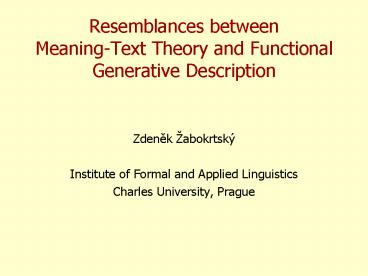Resemblances between MeaningText Theory and Functional Generative Description - PowerPoint PPT Presentation
Title:
Resemblances between MeaningText Theory and Functional Generative Description
Description:
sharing most of the 'peculiarities of the MTM' (Bolshakov ... 'distinguishing deep and surface syntactic representation' ... DSynt prosodic structure. in TGTS ... – PowerPoint PPT presentation
Number of Views:41
Avg rating:3.0/5.0
Title: Resemblances between MeaningText Theory and Functional Generative Description
1
Resemblances between Meaning-Text Theory and
Functional Generative Description
- Zdenek abokrtský
- Institute of Formal and Applied Linguistics
- Charles University, Prague
2
Functional Generative Description
- developed in Prague since mid 60s (Sgall,1967)
- sharing most of the peculiarities of the MTM
(Bolshakov and Gebulkh,2000) - multilevel character of the model
- orientation to synthesis
- distinguishing deep and surface syntactic
representation - accounting of communicative structure
- orientation to languages of a type different
from English - labeling syntactic relations between words
- keeping traditions and terminology of classical
linguistics
3
Levels of representationin MTT and FGD
semantic
tectogrammatical
deep-syntactic
surface-syntactic
surface-syntactic
deep-morphological
morphological
surface-morphological
morphonological
deep-phonological
phonetic
surface-phonological
4
DSyntR vs. tectogrammatics
- in both
- skelet of the representation dependency tree
(plus non-tree relations of co-reference) - nodes semantically full lexemes
- inflectional meanings grammemes/grammatemes
- ficitious lexemes
- valency actants vs. circumstantials
- in DSyntR
- DSynt prosodic structure
- in TGTS
- semantically motivated inventory of dependency
relations, so called functors (ACT, PAT, ADDR,
ORIG, EFF, CAUS, DIR?, LOC, TWHEN, CAUS, BEN...)
5
Side remark re-inventing the DSyntR/TGTS in
PropBank
- 2002 annotated propositions only verbs and
their arguments - adding modifiers of event variables
- adding arguments of nouns
- adding discourse connectives
6
FGD implementationPrague Dependency Treebank
- long-term research project aimed at creating a
syntactically annotated corpus based on the
framework of FGD - since 1995, inspired by Penn Treebank
- manually annotated Czech newspaper texts
- layered annotation scheme
- PDT 1.0 released in 2001 (distributed by LDC)
- PDT 2.0 to appear in 2006
7
Layered annotation scenarioof PDT 2.0
- 3 layers of annotation
- t-layer - tectogrammatical layer
- a-layer analytical layer
- m-layer morphological layer
- original text
- w-layer original sentence
8
m-layer sample
(Some contours of the problem seem to be clearer
after the resurgence by Havel's speech.)
9
a-layer sample
10
t-layer sample
11
Coordination in dependency trees in PDT
- physically still a tree structure, but tree edges
do not always directly correspond to dependencies - the real dependency and coordination relations
can be (deterministically) derived by edge
composition - direct vs. effective parent/children
12
PDT 2.0 amount of the data
13
Summary
- FGD similar to MTT in several aspects
- PDT implementation of FGD framework on a large
data































